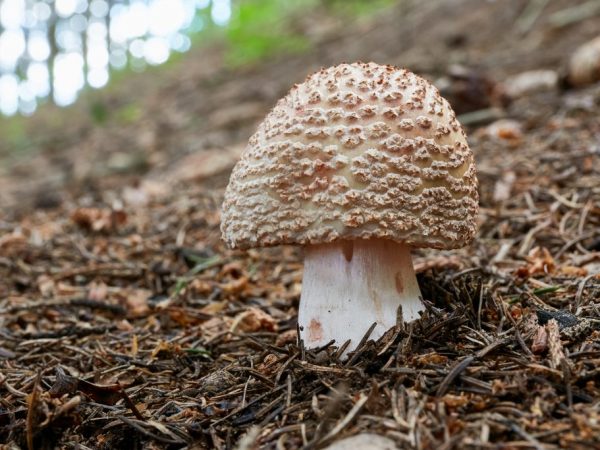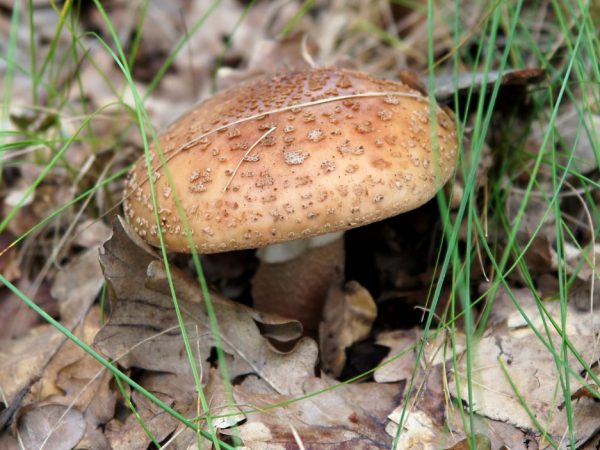Features of gray-pink fly agaric
Amanita muscaria belongs to the genus of the same name from the Amanitovye family. Unlike most fly agarics, this variety is conditionally edible.

Features of Amanita gray-pink
Botanical characteristic
The mushroom cap grows from 6 to 20 cm, but most often does not reach more than 15 cm in diameter. Initially, it has the shape of a hemisphere, later it becomes convex, and in overripe mushrooms it is flat-spread. The tubercle in the central part is not observed or it is so weakly expressed that it is practically invisible.
The cap is gray-pink in color, however, adult specimens with its red-brown coloration are sometimes found. Covered with warty or filmy scraps like fly agaric flakes, ranging in color from white to dark pink and brown. The skin on the cap is slightly sticky, with a characteristic shine.
Amanita gray-pink has several synonyms: reddening and pearl.
The mushroom flesh is white, with mechanical action it acquires a light pink color, then becomes a contrasting red. The structure is either fleshy or thin fleshy. Has a mild taste in the absence of a special smell.
The flesh of the species has the characteristic feature of blushing at the cut, which is where its name comes from.
The mushroom leg is in the form of a cylinder, from 3 to 10 cm high, sometimes grows up to 20 cm, 1.5-3.0 cm thick. Initially, the leg has a solid structure, as it grows it becomes hollow. The surface is bumpy, smooth or mealy, white to pink to purple in color. The lower part is thickened, often an object for the settlement and development of insect larvae, as a result of which colored passages appear in the fungus. On the widened tuberous part of the mushroom leg, the volva, which is inherent in all representatives of the genus Amanita, is clearly visible - weakly expressed, consisting of one or several rings.
Refers to basidiomycetes, multiplying by spores that form in clavate basidia.
Hymenophore plates of white color, often planted, wide in size, free, those. do not attach with one of their edges to the leg. Under mechanical stress, they begin to blush. The mushroom has a wide ring on the stem, formed from the remains of the bedspread. It is filmy in structure, hanging down.
Geography of distribution

The fungus grows on different types of soil
This fly agaric is common in areas where deciduous and coniferous trees grow, forming symbiotic associations with them of fungal mycelium with their root system (mycorrhiza), especially with birches and pines.
The fruiting period begins in early spring and lasts until the late autumn season; mass fruiting is observed between July and October.
Able to grow on different types of soil. It is found everywhere in the temperate zones of the Northern Hemisphere, with the exception of the North American continent. In the last century, it appeared in South Africa, where it was introduced by Europeans.Grows in small colonies or singly.
Similar varieties
According to the description, the pearl fly agaric in nature has several similar species that are poisonous:
- M. pantherny: its flesh is always white, the ring is thin, quickly disappearing, white, in contrast to the gray-pink fly agaric, the base of the leg is surrounded by an adherent, but easily detachable vagina.
- M. thick, or m. chunky: has a gray mushroom pulp under the skin of the cap, but its bulk is white, does not change color when exposed to air, it has a smell and taste reminiscent of turnips.
Irina Selyutina (Biologist):
The gray-pink fly agaric is really easy to distinguish from the poisonous congeners of the red and panther fly agaric precisely by the change in the color of the pulp at the site of the cut or break - it turns red. In addition, it is characterized by:
- The white plates of the hymenophore turn red with old age;
- The leg, as the mushroom develops, turns from white to reddish;
- The white ring on the leg also turns red over time.
- The vagina is represented by flakes that quickly disappear.
Having decided to collect an edible fly agaric, you need to be extremely careful so that its poisonous counterparts do not fall into your basket.
Gastronomic qualities
Pearl fly agaric is considered a conditionally edible mushroom, but fresh for food purposes it is unsuitable. In the chemical composition of the raw fly agaric, there are thermolabile (destroyed under the influence of high temperatures) substances that have a toxic effect on human health. It is usually eaten fried after prolonged pre-boiling with frequent water changes. Suitable for pickles and salting.
It is believed that it is from dried mushroom caps that the most delicious soup is obtained, and young fruiting bodies with unopened caps can be grilled or eaten raw, adding to salads. Those who have tried the gray-pink fly agaric claim that the pulp of this mushroom tastes like chicken.
No hallucinogenic properties have been found in the pearl species.
Conclusion
Amanita muscaria is included in the genus of the same name of the Amanitovye family. It grows everywhere in the northern hemisphere. Has similar poisonous species. It is conditionally edible and suitable for food purposes after prolonged heat treatment.



